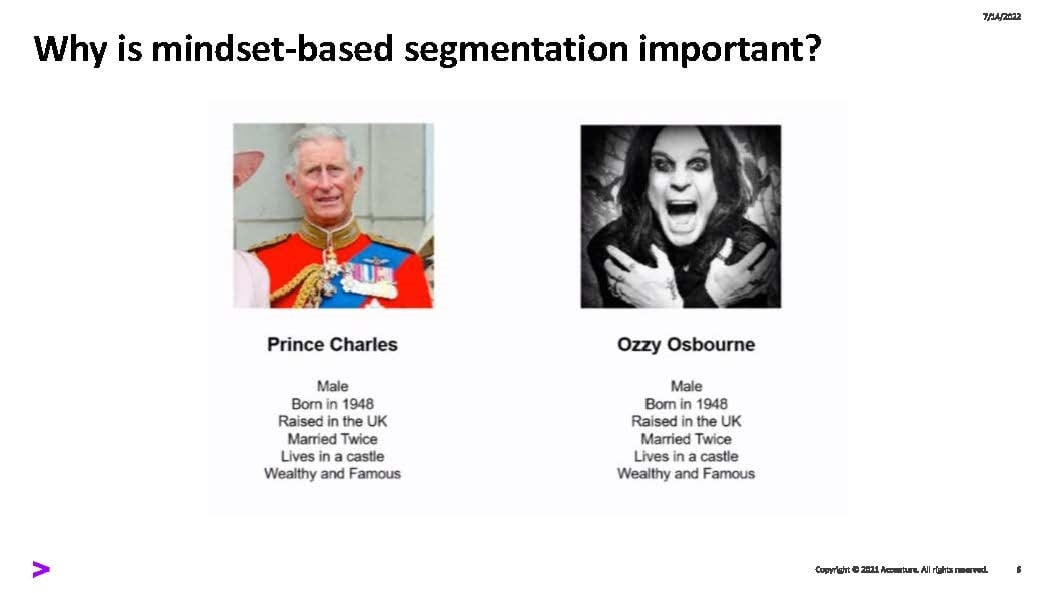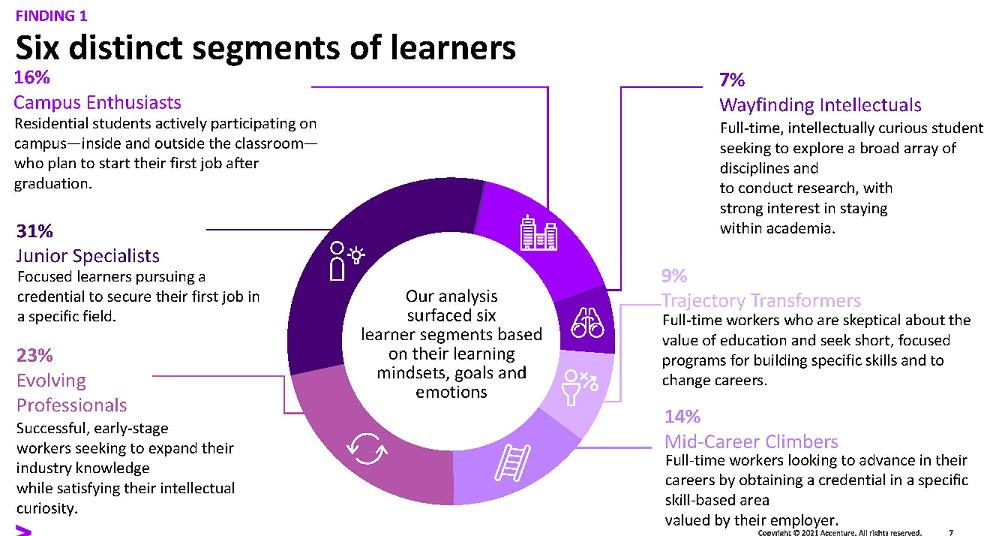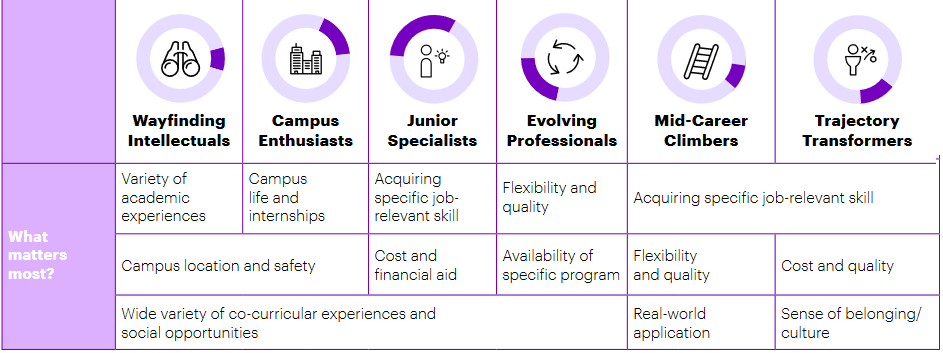
Understanding today’s and tomorrow’s learners and their mind-sets
Author: Doug Lederman
Go to Source

DENVER—Rare is the college or university that doesn’t need to be thinking about where its future students might come from. Most colleges—be they enrollment-driven four-year colleges that have historically focused on the stagnant or shrinking pipeline of students right out of high school, or community colleges struggling to persuade workers to forgo $18-an-hour jobs for more training—face an uncertain enrollment future.
But it’s one thing for an institution to know in theory that it must identify new pools of prospective students or develop a strategy to meet the growing demand for “lifelong learning”—and quite another to really understand what different kinds of learners want and which groups a particular college is best positioned to serve, in a way that’s consistent with its mission.
One framework for doing so was laid out here at this week’s annual meeting of the National Association of College and University Business Officers. Samantha Fisher, who leads the North American education practice for the business and technology consulting firm Accenture, laid out a new way of thinking about students for a group of administrators responsible for keeping their colleges’ budgets healthy.
Fisher presented the results of a survey of 6,500 learners that Accenture released last fall. The use of the term learners (instead of “students”) isn’t accidental; while more than half of those surveyed are currently enrolled in college degree or certificate programs, the survey included those who were “willing or had recently been paying to get any kind of credential” from any type of education or training provider, Fisher said, including boot camps, corporate providers and the like.
That’s important, because colleges and universities are increasingly competing against not only each other but an ever-broadening array of alternative providers who might offer education or training more affordably, more conveniently or even more effectively.
By including not only students who are currently enrolled at a college or university program but also those who may have dropped out or chosen an alternative, the survey offers insights not only into what choices learners are making but “their levels of satisfaction” with different kinds of educational providers and “what universities might need to do better” to compete for and serve learners, Fisher said. (It should be noted that this analysis excludes some of the many millions of Americans who have opted out of education and training altogether, focusing instead on those likeliest to potentially be interested in a formal program.)
Thinking about their current and potential students, most college officials lean heavily on demographics, which makes a certain kind of sense, Fisher said; it’s often how we distinguish among people in many realms. But demographics alone tell you only so much, especially about preferences and predilections. To laughter from the audience, Fisher shared the slide shown above, which based on demographics alone would make two Brits—Prince Charles and Ozzy Osbourne—seem virtually interchangeable.
“I doubt that they think and act very much alike,” Fisher said of the duo. “I don’t know them personally, but I’m just taking a guess.”
Accenture presents mind-set as an alternative, focused on learners’ goals and emotions rather than immutable characteristics such as age, race, geography or gender.
“We took this approach because demographic-based segmentation misses key elements of rapidly evolving human needs and learner expectations, particularly when looking at learners across different life stages,” the report states.
The report separates learners into six categories, listed here from most to least likely to currently be enrolled in a traditional college or university or academic program. The proportion of all learners they represent are in parentheses:
- Wayfinding intellectuals (7 percent): Full-time, intellectually curious students seeking to explore a broad array of disciplines and to conduct research, with strong interest in staying within academe. Picture the most traditional student at a liberal arts college, there as much for mind expansion as for future career success.
- Campus enthusiasts (16 percent): Residential students actively participating on campus—inside and outside the classroom—who plan to start their first job after graduation. Envision students at a major public university active in a sorority, on a sports team, in student government or more.
- Junior specialists (31 percent): Focused learners pursuing a credential to secure their first job in a specific field—a student entering nursing school or a commuting student who chose accounting as a major.
- Evolving professionals (23 percent): Successful, early-stage workers seeking to expand their industry knowledge while satisfying their intellectual curiosity. The office worker who goes back for an M.B.A., for whom another credential is the “natural next step in career growth through intellectual activity,” Fisher said.
- Midcareer climbers (14 percent): Full-time workers looking to advance in their careers by obtaining a credential in a specific skill-based area valued by their employer.
- Trajectory transformers (9 percent): Full-time workers who are skeptical about the value and outcomes of credentials but seek short, focused programs for building specific skills and being able to change careers.

The first four can best be viewed as traditional college or university students (though not all of them are in the population of 18- to 22-year-olds that is facing a significant demographic decline), while the latter fall squarely into the camp of nontraditional or post-traditional learners.
Fisher said Accenture found a surprising degree of demographic similarity across the learner types, but differences emerged in what matters most to them, their satisfaction levels, as seen below:

Most learners of all types expressed an interest in flexibility and a quality digital experience, but that doesn’t mean they all want all their learning and experiences to be virtual.
“Students value being in person, but for the right things,” Fisher said. “They value a campus experience for deeply relevant social experiences, like orientation and sports, but pervasively preferred online delivery for administrative services.”
What should institutions do with this framework?
It’s important for them to understand the learner segments they already have and those they might want to pursue in the future, and to think about building long-term relationships with learners, so they have offerings and services for them at every stage, Fisher said.
They should also distribute resources to correlate with the needs and mind-sets of the learners they have and those they want to have.
“If 100 percent of your students are campus enthusiasts, it might not be a bad investment to have a climbing wall,” Fisher said, referring to the stereotypically derided offering of some campuses focused exclusively on satisfying traditional residential students. “But if most of your current or future students are specialists,” she said, “it just might make more sense to invest in career services.”
